Do you have a question about the MSI X299 TOMAHAWK and is the answer not in the manual?
Lists essential tools and components for PC assembly.
Step-by-step guide for installing the CPU onto the motherboard.
Detailed instructions for installing DDR4 memory modules.
Guide for connecting front panel connectors to the motherboard header.
Instructions on how to physically install the motherboard into the PC case.
Steps for installing SATA drives (HDD/SSD) into the system.
Guide for installing a graphics card into the PCIe slot.
Connects external devices like keyboard, mouse, monitor, and speakers.
Illustrates connecting ATX and CPU power cables to the motherboard.
Final steps to power on the computer after assembly.
Details about the supported CPU and socket type.
Information about the motherboard's chipset.
Specifications for DDR4 memory slots and support.
Details on PCIe slots and their configurations.
Information on multi-GPU support technologies.
Details about the integrated LAN controller.
Specifications for the optional wireless and Bluetooth module.
Specifications for the onboard audio codec and features.
Details on USB controller chipsets and port specifications.
Specifications for SATA, M.2, and U.2 storage interfaces.
Information on supported RAID levels for storage devices.
Lists and describes various internal connectors on the motherboard.
Lists and describes the connectors on the rear I/O panel.
Identifies the I/O controller chip used on the motherboard.
Features for monitoring system temperature and fan speeds.
Specifies the physical dimensions of the motherboard.
Lists key BIOS features and capabilities.
Lists bundled software applications and utilities.
Highlights unique MSI features and technologies.
Lists unique MSI features and technologies.
Explains the status indicators for the LAN port.
Diagrams showing audio port connections for different speaker setups.
Overview and explanation of the Realtek HD Audio Manager software.
Illustrates connections for headphones, speakers, and surround sound.
Instructions for installing the optional Wi-Fi antennas.
Provides information about the LGA 2066 CPU and its alignment keys.
Key safety and installation notes for the CPU socket and installation.
Guide for installing memory modules for 4-channel CPU configurations.
Important notes regarding DIMM slot installation and memory compatibility.
Guide for installing memory modules for 2-channel CPU configurations.
Details on PCIe slots and their configurations.
Table detailing bandwidth configurations for PCIe slots based on CPU lanes.
Recommendations for installing multiple graphics cards for optimal performance.
Critical advice for installing PCIe expansion cards.
Instructions for installing and configuring NVIDIA SLI graphics cards.
Steps for connecting a U.2 SSD to the motherboard.
Important note about U.2 port availability based on PCIe slot usage.
Step-by-step guide for installing an M.2 module into the slot.
Information on using the M.2 FROZR heatsink for thermal dissipation.
Important notes regarding M.2 module installation and the FROZR.
Important advice on handling SATA cables to prevent data loss.
Table showing compatibility and usage combinations between slots.
Illustrates various possible configurations for M.2 slots with other interfaces.
Crucial reminder to ensure secure power cable connections for stability.
Explains the connector for the specific Intel module/key for Virtual RAID.
Connects front panel switches and LEDs to the motherboard.
Important note on correct power and ground pin connections to prevent damage.
Allows connection of USB 3.1 Gen2 Type-C ports on the front panel.
Critical warnings to prevent operating system damage when enabling Optane memory.
Important note on correct VCC and Ground pin connections to prevent damage.
Connector for the Trusted Platform Module (TPM).
Important note to check fan operation after switching PWM/DC mode.
Connector for adding a Thunderbolt I/O card.
Connects front panel audio jacks to the motherboard.
Guide on how to enable and use the chassis intrusion detection feature.
Steps to reset the chassis intrusion warning message.
Procedure to recover the BIOS using the multi-BIOS switch.
Important warnings regarding the use of the Multi-BIOS switch during boot.
Step-by-step guide to reset BIOS settings to default values.
Describes the function of the power and reset buttons.
Important notes on RGB LED strip compatibility, power limits, and software control.
Explains the function of EZ Debug LEDs for diagnosing boot issues.
Indicates the function of DIMM LEDs for memory installation status.
Explains the XMP LED status for Extreme Memory Profile mode.
Describes LED indicators for fan control modes (PWM/DC).
Explains LED indicators for PCIe slot speed status.
Table showing hexadecimal characters displayed by the debug code LED.
Explains the different boot phases indicated by debug codes.
Comprehensive table detailing debug codes for progress and errors.
Methods to access the BIOS setup utility.
Procedures for resetting BIOS settings to default values.
Step-by-step guide to update BIOS using the M-FLASH utility.
Instructions for updating BIOS using the MSI Live Update 6 software.
Guide for updating BIOS using the BIOS FLASHBACK+ feature.
Important advice regarding changes in OC menu and GAME BOOST function.
Explains how to display system information within EZ Mode.
Describes the function of various buttons in EZ Mode.
How to manage favorite BIOS settings pages in EZ Mode.
Overview of the main BIOS menu options available in Advanced Mode.
Displays system date, time, and connected SATA/M.2/U.2 devices.
Shows detailed system information like CPU type and BIOS version.
Displays system, board, and chassis information.
Access to advanced system settings and configurations.
Configures PCI Express link speed for PCIe x16 slots.
Sets the latency timer for PCI interface devices.
Enables/disables 64-bit device decoding for large memory or mining.
Configures onboard power LED behaviors and system power states.
Manages settings for integrated peripherals like LAN, HDD, USB, and audio.
Sets the operation mode for onboard SATA controllers (AHCI/RAID).
Enables/disables Intel RST support for M.2 PCIe SSDs or Optane memory.
Configures onboard USB controllers and device functions.
Sets system power management behaviors like AC power loss and OS configuration.
Configures Windows OS specific behaviors like WHQL support and Fast Boot.
Enables/disables MSI Fast Boot for accelerated system startup.
Manages Windows secure boot settings for system security.
Selects the secure boot mode and key loading method.
Configures system wake-up behaviors based on various events.
Configures system boot device sequence and options.
Manages system security settings like administrator and user passwords.
Configures the chassis intrusion detection feature and warning messages.
Options for saving changes, discarding them, and exiting the BIOS setup.
Selects between Normal and Expert views for OC settings.
Sets how CPU ratio is applied (All Core or Per Core).
Adjusts the CPU ratio to determine CPU clock speed.
Shows the currently adjusted CPU frequency.
Selects the CPU ratio operating mode (Fixed or Dynamic).
Adjusts CPU core ratio for heat dissipation during AVX instructions.
Sets the ring ratio, affecting CPU performance.
Accesses settings related to CPU features like EIST and Turbo Boost.
Enables or disables Intel Turbo Boost for increased CPU performance.
Configures memory overclocking profiles via X.M.P.
Adjusts the DRAM frequency for memory performance tuning.
Detailed settings for memory timing configuration for all channels.
Enables or disables memory initiation and training during boot.
Manages SVID support for dynamic PWM phase adjustment.
Allows manual adjustment of voltages related to the CPU.
Allows manual adjustment of voltages related to the memory modules.
Displays detailed information about the installed CPU.
Configures CPU-specific features like Hyper-Threading and core activation.
Enables or disables Intel Hyper-Threading technology for improved multitasking.
Selects the number of active CPU cores to be utilized.
Enables Intel Virtualization Technology for running multiple OS.
Enables or disables Intel VT-D technology for directed I/O.
Controls the hardware prefetcher for cache performance tuning.
Manages Intel adaptive thermal monitor to prevent CPU overheating.
Controls Intel C-state for processor power management.
Locks or unlocks the CFG lock bit for system security.
Sets the long duration TDP power limit for CPU in Turbo Boost.
Sets the maximum current limit for CPU package in Turbo Boost mode.
Sets the FCLK frequency for early power on.
Step-by-step guide for installing the Windows 10 operating system.
Instructions for installing essential system drivers from the disc.
Guide for installing bundled software utilities from the driver disc.
Manages MSI applications and provides update information.
Instructions for updating system drivers and BIOS using Live Update 6.
Describes the Total Installer feature for simplified software installation.
Software for adjusting system settings and monitoring status under OS.
Controls CPU fan speed via Smart or Manual modes.
Allows control over CPU voltage settings.
Displays and allows adjustment of DRAM frequency and voltage.
Provides specified CPU frequency for overclocking the CPU.
Configures threshold values for system status warnings.
Enables remote control of COMMAND CENTER via a mobile device.
Monitors system status using a gadget mode interface.
Application for quick system control and performance enhancement.
Configures on-screen display (OSD) information within GAMING APP.
Optimizes display settings to reduce eye strain.
Optimizes system performance for Virtual Reality readiness.
Provides instant system control via user-defined hotkeys.
Manages mouse macro functions and DPI settings.
Selects system performance modes for enhanced speed.
Enables USB SPEED UP, STORAGE BOOST, and VR BOOST in X-BOOST.
Application to control LED lighting effects of MSI products.
Configures LED lighting effects for the motherboard.
Utility for creating Windows installation USB drives with USB 3.0 drivers.
Utility for creating software RAID volumes in Windows.
Creates a virtual RAM drive for faster storage access.
Utility for traffic shaping and optimizing internet connection.
Guide for testing and configuring internet upload/download speeds.
Allows watching game guides and streams with hotkey controls.
Accesses Nahimic 2's audio effects, profiles, and settings.
Accesses Nahimic 2's microphone effects and settings.
Features for audio recording and processing within Nahimic 2.
Visualizes sound sources in FPS games using DirectX.
Details on Sound Tracker functionality and controls.
Lists hardware and software requirements for XSplit Gamecaster.
Instructions for logging into XSplit Gamecaster.
Guide to learn streaming and recording features in XSplit Gamecaster.
Manages social network connections for sharing streams and recordings.
Configures stream and recording settings, and microphone input.
Manages and organizes recorded gameplay videos.
Software for customizing SteelSeries device settings.
Customizes device settings and configurations within SteelSeries Engine.
Software for tuning, testing, and monitoring system overclocking.
Utility that gathers information on system hardware.
Enables playing PC games in a 3D virtual reality environment.
Manages and launches games within the TriDef VR environment.
Describes controls for recentering and adjusting the VR view.
Adjusts virtual screen settings, game 3D, and output quality.
Replaces or blurs backgrounds in video chat or XSplit.
Guide to enter and use the Intel RST Option ROM for RAID setup.
Step-by-step process for creating a RAID volume using Intel RST.
Instructions for deleting a RAID volume and resetting disks.
Process to remove RAID structures and revert disks to non-RAID status.
Options for configuring recovery volumes for RAID arrays.
Explains degraded RAID status and procedures to restore data redundancy.
Steps to replace a failed hard drive and rebuild the RAID array.
Guide to create M.2 PCIe SSD RAID using M.2/Optane Genie.
Guide to create M.2 PCIe SSD RAID using UEFI BIOS settings.
Detailed steps for creating a RAID volume for M.2 PCIe SSDs.
Instructions to remove M.2 PCIe SSD RAID using M.2/Optane Genie.
Instructions to remove M.2 PCIe SSD RAID using UEFI BIOS.
Lists the requirements for installing Intel® Optane™ memory.
Step-by-step guide for installing the Intel® Optane™ memory module.
Instructions to enable Intel® Optane™ Memory via the application.
Critical warnings to prevent operating system damage when enabling Optane memory.
Steps to disable and remove the Intel® Optane™ memory module.
Addresses common problems like power, no signal, boot failures, audio, network, and USB issues.
Lists essential tools and components for PC assembly.
Step-by-step guide for installing the CPU onto the motherboard.
Detailed instructions for installing DDR4 memory modules.
Guide for connecting front panel connectors to the motherboard header.
Instructions on how to physically install the motherboard into the PC case.
Steps for installing SATA drives (HDD/SSD) into the system.
Guide for installing a graphics card into the PCIe slot.
Connects external devices like keyboard, mouse, monitor, and speakers.
Illustrates connecting ATX and CPU power cables to the motherboard.
Final steps to power on the computer after assembly.
Details about the supported CPU and socket type.
Information about the motherboard's chipset.
Specifications for DDR4 memory slots and support.
Details on PCIe slots and their configurations.
Information on multi-GPU support technologies.
Details about the integrated LAN controller.
Specifications for the optional wireless and Bluetooth module.
Specifications for the onboard audio codec and features.
Details on USB controller chipsets and port specifications.
Specifications for SATA, M.2, and U.2 storage interfaces.
Information on supported RAID levels for storage devices.
Lists and describes various internal connectors on the motherboard.
Lists and describes the connectors on the rear I/O panel.
Identifies the I/O controller chip used on the motherboard.
Features for monitoring system temperature and fan speeds.
Specifies the physical dimensions of the motherboard.
Lists key BIOS features and capabilities.
Lists bundled software applications and utilities.
Highlights unique MSI features and technologies.
Lists unique MSI features and technologies.
Explains the status indicators for the LAN port.
Diagrams showing audio port connections for different speaker setups.
Overview and explanation of the Realtek HD Audio Manager software.
Illustrates connections for headphones, speakers, and surround sound.
Instructions for installing the optional Wi-Fi antennas.
Provides information about the LGA 2066 CPU and its alignment keys.
Key safety and installation notes for the CPU socket and installation.
Guide for installing memory modules for 4-channel CPU configurations.
Important notes regarding DIMM slot installation and memory compatibility.
Guide for installing memory modules for 2-channel CPU configurations.
Details on PCIe slots and their configurations.
Table detailing bandwidth configurations for PCIe slots based on CPU lanes.
Recommendations for installing multiple graphics cards for optimal performance.
Critical advice for installing PCIe expansion cards.
Instructions for installing and configuring NVIDIA SLI graphics cards.
Steps for connecting a U.2 SSD to the motherboard.
Important note about U.2 port availability based on PCIe slot usage.
Step-by-step guide for installing an M.2 module into the slot.
Information on using the M.2 FROZR heatsink for thermal dissipation.
Important notes regarding M.2 module installation and the FROZR.
Important advice on handling SATA cables to prevent data loss.
Table showing compatibility and usage combinations between slots.
Illustrates various possible configurations for M.2 slots with other interfaces.
Crucial reminder to ensure secure power cable connections for stability.
Explains the connector for the specific Intel module/key for Virtual RAID.
Connects front panel switches and LEDs to the motherboard.
Important note on correct power and ground pin connections to prevent damage.
Allows connection of USB 3.1 Gen2 Type-C ports on the front panel.
Critical warnings to prevent operating system damage when enabling Optane memory.
Important note on correct VCC and Ground pin connections to prevent damage.
Connector for the Trusted Platform Module (TPM).
Important note to check fan operation after switching PWM/DC mode.
Connector for adding a Thunderbolt I/O card.
Connects front panel audio jacks to the motherboard.
Guide on how to enable and use the chassis intrusion detection feature.
Steps to reset the chassis intrusion warning message.
Procedure to recover the BIOS using the multi-BIOS switch.
Important warnings regarding the use of the Multi-BIOS switch during boot.
Step-by-step guide to reset BIOS settings to default values.
Describes the function of the power and reset buttons.
Important notes on RGB LED strip compatibility, power limits, and software control.
Explains the function of EZ Debug LEDs for diagnosing boot issues.
Indicates the function of DIMM LEDs for memory installation status.
Explains the XMP LED status for Extreme Memory Profile mode.
Describes LED indicators for fan control modes (PWM/DC).
Explains LED indicators for PCIe slot speed status.
Table showing hexadecimal characters displayed by the debug code LED.
Explains the different boot phases indicated by debug codes.
Comprehensive table detailing debug codes for progress and errors.
Methods to access the BIOS setup utility.
Procedures for resetting BIOS settings to default values.
Step-by-step guide to update BIOS using the M-FLASH utility.
Instructions for updating BIOS using the MSI Live Update 6 software.
Guide for updating BIOS using the BIOS FLASHBACK+ feature.
Important advice regarding changes in OC menu and GAME BOOST function.
Explains how to display system information within EZ Mode.
Describes the function of various buttons in EZ Mode.
How to manage favorite BIOS settings pages in EZ Mode.
Overview of the main BIOS menu options available in Advanced Mode.
Displays system date, time, and connected SATA/M.2/U.2 devices.
Shows detailed system information like CPU type and BIOS version.
Displays system, board, and chassis information.
Access to advanced system settings and configurations.
Configures PCI Express link speed for PCIe x16 slots.
Sets the latency timer for PCI interface devices.
Enables/disables 64-bit device decoding for large memory or mining.
Configures onboard power LED behaviors and system power states.
Manages settings for integrated peripherals like LAN, HDD, USB, and audio.
Sets the operation mode for onboard SATA controllers (AHCI/RAID).
Enables/disables Intel RST support for M.2 PCIe SSDs or Optane memory.
Configures onboard USB controllers and device functions.
Sets system power management behaviors like AC power loss and OS configuration.
Configures Windows OS specific behaviors like WHQL support and Fast Boot.
Enables/disables MSI Fast Boot for accelerated system startup.
Manages Windows secure boot settings for system security.
Selects the secure boot mode and key loading method.
Configures system wake-up behaviors based on various events.
Configures system boot device sequence and options.
Manages system security settings like administrator and user passwords.
Configures the chassis intrusion detection feature and warning messages.
Options for saving changes, discarding them, and exiting the BIOS setup.
Selects between Normal and Expert views for OC settings.
Sets how CPU ratio is applied (All Core or Per Core).
Adjusts the CPU ratio to determine CPU clock speed.
Shows the currently adjusted CPU frequency.
Selects the CPU ratio operating mode (Fixed or Dynamic).
Adjusts CPU core ratio for heat dissipation during AVX instructions.
Sets the ring ratio, affecting CPU performance.
Accesses settings related to CPU features like EIST and Turbo Boost.
Enables or disables Intel Turbo Boost for increased CPU performance.
Configures memory overclocking profiles via X.M.P.
Adjusts the DRAM frequency for memory performance tuning.
Detailed settings for memory timing configuration for all channels.
Enables or disables memory initiation and training during boot.
Manages SVID support for dynamic PWM phase adjustment.
Allows manual adjustment of voltages related to the CPU.
Allows manual adjustment of voltages related to the memory modules.
Displays detailed information about the installed CPU.
Configures CPU-specific features like Hyper-Threading and core activation.
Enables or disables Intel Hyper-Threading technology for improved multitasking.
Selects the number of active CPU cores to be utilized.
Enables Intel Virtualization Technology for running multiple OS.
Enables or disables Intel VT-D technology for directed I/O.
Controls the hardware prefetcher for cache performance tuning.
Manages Intel adaptive thermal monitor to prevent CPU overheating.
Controls Intel C-state for processor power management.
Locks or unlocks the CFG lock bit for system security.
Sets the long duration TDP power limit for CPU in Turbo Boost.
Sets the maximum current limit for CPU package in Turbo Boost mode.
Sets the FCLK frequency for early power on.
Step-by-step guide for installing the Windows 10 operating system.
Instructions for installing essential system drivers from the disc.
Guide for installing bundled software utilities from the driver disc.
Manages MSI applications and provides update information.
Instructions for updating system drivers and BIOS using Live Update 6.
Describes the Total Installer feature for simplified software installation.
Software for adjusting system settings and monitoring status under OS.
Controls CPU fan speed via Smart or Manual modes.
Allows control over CPU voltage settings.
Displays and allows adjustment of DRAM frequency and voltage.
Provides specified CPU frequency for overclocking the CPU.
Configures threshold values for system status warnings.
Enables remote control of COMMAND CENTER via a mobile device.
Monitors system status using a gadget mode interface.
Application for quick system control and performance enhancement.
Configures on-screen display (OSD) information within GAMING APP.
Optimizes display settings to reduce eye strain.
Optimizes system performance for Virtual Reality readiness.
Provides instant system control via user-defined hotkeys.
Manages mouse macro functions and DPI settings.
Selects system performance modes for enhanced speed.
Enables USB SPEED UP, STORAGE BOOST, and VR BOOST in X-BOOST.
Application to control LED lighting effects of MSI products.
Configures LED lighting effects for the motherboard.
Utility for creating Windows installation USB drives with USB 3.0 drivers.
Utility for creating software RAID volumes in Windows.
Creates a virtual RAM drive for faster storage access.
Utility for traffic shaping and optimizing internet connection.
Guide for testing and configuring internet upload/download speeds.
Allows watching game guides and streams with hotkey controls.
Accesses Nahimic 2's audio effects, profiles, and settings.
Accesses Nahimic 2's microphone effects and settings.
Features for audio recording and processing within Nahimic 2.
Visualizes sound sources in FPS games using DirectX.
Details on Sound Tracker functionality and controls.
Lists hardware and software requirements for XSplit Gamecaster.
Instructions for logging into XSplit Gamecaster.
Guide to learn streaming and recording features in XSplit Gamecaster.
Manages social network connections for sharing streams and recordings.
Configures stream and recording settings, and microphone input.
Manages and organizes recorded gameplay videos.
Software for customizing SteelSeries device settings.
Customizes device settings and configurations within SteelSeries Engine.
Software for tuning, testing, and monitoring system overclocking.
Utility that gathers information on system hardware.
Enables playing PC games in a 3D virtual reality environment.
Manages and launches games within the TriDef VR environment.
Describes controls for recentering and adjusting the VR view.
Adjusts virtual screen settings, game 3D, and output quality.
Replaces or blurs backgrounds in video chat or XSplit.
Guide to enter and use the Intel RST Option ROM for RAID setup.
Step-by-step process for creating a RAID volume using Intel RST.
Instructions for deleting a RAID volume and resetting disks.
Process to remove RAID structures and revert disks to non-RAID status.
Options for configuring recovery volumes for RAID arrays.
Explains degraded RAID status and procedures to restore data redundancy.
Steps to replace a failed hard drive and rebuild the RAID array.
Guide to create M.2 PCIe SSD RAID using M.2/Optane Genie.
Guide to create M.2 PCIe SSD RAID using UEFI BIOS settings.
Detailed steps for creating a RAID volume for M.2 PCIe SSDs.
Instructions to remove M.2 PCIe SSD RAID using M.2/Optane Genie.
Instructions to remove M.2 PCIe SSD RAID using UEFI BIOS.
Lists the requirements for installing Intel® Optane™ memory.
Step-by-step guide for installing the Intel® Optane™ memory module.
Instructions to enable Intel® Optane™ Memory via the application.
Critical warnings to prevent operating system damage when enabling Optane memory.
Steps to disable and remove the Intel® Optane™ memory module.
Addresses common problems like power, no signal, boot failures, audio, network, and USB issues.
| Socket | LGA 2066 |
|---|---|
| Chipset | Intel X299 |
| Form Factor | ATX |
| Max Memory Support | 128GB |
| PCIe x16 Slots | 3 |
| SATA 6Gb/s | 8 |
| M.2 Slots | 2 |
| U.2 Ports | 1 |
| USB 3.2 Gen 1 (Rear) | 4 |
| USB 2.0 (Rear) | 2 |
| Audio | Realtek ALC1220 Codec |
| RAID Support | 0, 1, 5, 10 |
| Memory Speed | 2666/ 2400/ 2133 MHz |
| Storage Interface | SATA, M.2, U.2 |
| USB 3.2 Gen 2 (Rear) | 1 x Type-A, 1 x Type-C |
| LAN | Intel I219-V Gigabit LAN |

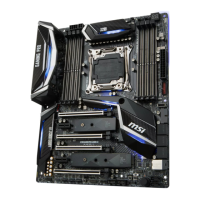
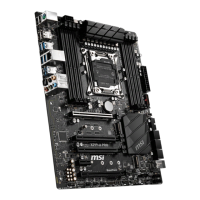
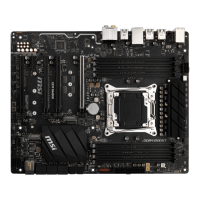
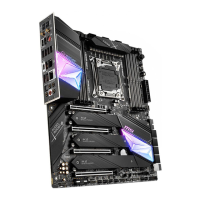

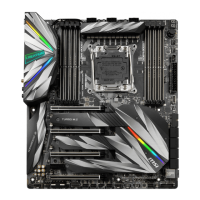
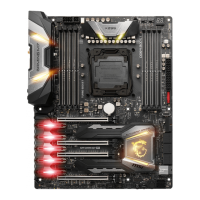

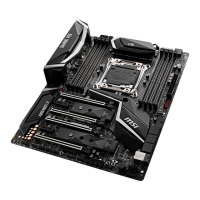

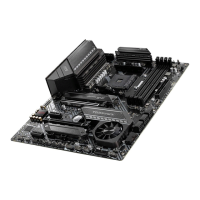
